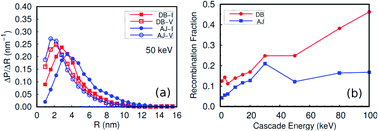Individual cascade annealing in BCC tungsten: effects of size and spatial distributions of defects
Abstract
To investigate effects of size and spatial distributions of defects from primary damage to annealing of an individual cascade, molecular dynamics (MD) and object kinetic Monte Carlo (OKMC) are applied for simulating cascade generation and annealing. MD cascade simulations of tungsten are carried out with two typical embedded atom method potentials for cascade energies in the range from 0.1 to 100 keV at 300 K. The simulation results show that even though the number of survival defects varies slightly, these two potentials produce very different interstitial cluster (IC) size distribution and defect spatial distribution with cascade energies larger than 30 keV. Furthermore, OKMC is used to model individual cascade annealing. It demonstrates that larger-sized ICs and closely distributed SIAs in the cascade region will induce a much higher recombination fraction for individual cascade annealing. Therefore, special attention should be paid to the size and spatial distributions of defects for primary damage in the multi-scale simulation framework.



 Please wait while we load your content...
Please wait while we load your content...